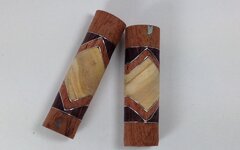NittanyLion
Member
Tired of blow outs, I might try something different. I had these all glued up(epoxy), turned round, bits sharpened, skew sharpened,.......and then I wondered.......what If I put it in my chamber and put the Cactus Juice to it? Has anyone ever tried this? I wonder about the aluminum in the oven separating from the glue/Resin. Any experience before I possibly ruin a good set of blanks?

